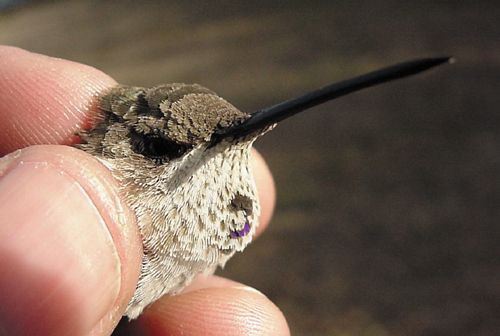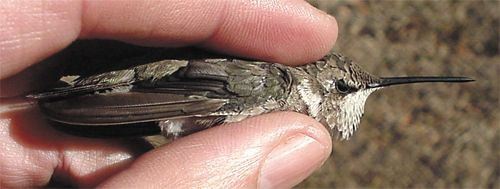|
|
|||
|
THIS WEEK at HILTON POND |
|
The population of winter vagrant hummingbirds in the Carolinas usually begins to dwindle by late February. Some birds are moving back toward their breeding grounds, while others may be meandering off to points unknown. And then there are those unlucky ones that perished due to weather, lack of food, or both. Some hummers that survived the winter chill are still sipping sugar water at places where they were first seen, and a bird reported this week from Lexington, South Carolina proves that new vagrant hummingbirds can still be spotted late in the winter season.  Such was the case when Deb Rosengrant looked out her window on 28 February 2002 and saw a hummingbird fly toward a decorative rock waterfall in her backyard. Undoubtedly attracted by the sound and sight of flowing water, the bird perched and then drank from a shallow, cup-sized pool among the rocks. After rubbing her eyes with disbelief, Deb immediately hung a couple of hummingbird feeders and was pleased over the next few days to see the hummer make hourly visits. Alerted to the research value of winter hummingbirds by a link from Audubon's Great Backyard Bird Count, Deb contacted Hilton Pond Center a few days after her hummer arrived, and we were off for Lexington well before dawn on 7 March. Since the Lexington bird had a green back and white belly, Deb first thought she had attracted a female Ruby-throated Hummingbird, but when she reported that it had several dark spots on its throat we suspected a female (or second-year male) Rufous Hummingbird--by far the most common winter hummer in the eastern U.S. Besides, 28 February would be an extremely early date for a spring migrant ruby-throat at an inland site; virtually all the overwintering ruby-throats in the eastern U.S.--and there have been relatively few--are found in coastal areas, perhaps because the climate there is more moderate.
After setting up the trap on Deb's back patio precisely at 7 a.m., we settled back and listened to the gurgling waterfall while awaiting our first winter hummer since mid-January. (It had been a long six weeks, and we needed a hummingbird "fix.") Almost an hour later--it only seemed longer because of temperatures in the 30s--the hummer finally zipped in and made its first sortie toward the feeder, constantly pumping and spreading its tail as it dipped and hovered. Unaccustomed to finding the feeder surrounded by wire mesh, the hummingbird backed away and perched in some nearby shrubbery and then returned, making several visits before figuring out how to enter the trap. Finally, just after the hummer buzzed through the trapdoor, we pulled the string and had a hummingbird in hand at 7:55 a.m. This new capture was the size of a Ruby-throated Hummingbird, but as soon as we saw the throat feathers we knew that's not what it was. Instead of being red, some of of the gorget spots were velvety black and some were brilliant purple; it could be none other than a second-year male Black-chinned Hummingbird! Less than a half-dozen vagrant black-chins have been banded in the Carolinas, and--as with the wintering ruby-throats--most have been found along the coast. We were especially pleased to be eye-to-eye with a Black-chinned Hummingbird because it was the first we had ever captured; plus, it became the fourth vagrant hummingbird species banded by Center staff in South Carolina during the winter of 2001-2002. Black-chinned Hummingbirds, Archilochus alexandri, are congeners and western counterparts to A. colubris, the Ruby-throated Hummingbird. Although ruby-throats breed in southern Canada and across the eastern two-thirds of the U.S., the black-chin is restricted primarily to the Rocky Mountain states, Washington, Oregon, California, Texas, Mexico, and extreme southern British Columbia. Females of the two species are nearly indistinguishable in the field. Males, however, are decidedly different; one species has a dark chin bordered by a seldom-seen throat band of iridescent purple, while the other has an obvious and uniformly ruby-red gorget. Young males of both species resemble females, but by mid-winter they typically sport a partial or full gorget of the color appropriate for their particular species. The Lexington black-chin appeared to be a little behind in his development; not only did he not yet have his complete complement of throat feathers, but his head and body feathers were dingy and worn--almost gray--except in a few places where the adult plumage of iridescent green was beginning to come in (above).
The wing photo reveals another interesting difference between ruby-throats and black-chins. In the former, the tenth (outermost) primary feather is rather narrow and tapered, while that of the black-chin is wide and rounded, as shown above right. This characteristic isn't typically visible in the field, but we bet a person with acute hearing and perfect pitch can tell the difference in the "hums" produced by these different wing shapes. And one other thing. That near-constant tail-pumping we observed when Deb Rosengrant's black-chin first approached the trap is a behavior typical of the species. Ruby-throats also pump their tails, but not nearly as much as their western cousins. We suspect this Lexington Black-chinned Hummingbird will stay around for another week or so, but after that it had best make a bee-line westward. After all, the first migrant Ruby-throated Hummingbirds of 2002 will be expected at Hilton Pond Center and points north by the last week in March, and we wouldn't want to get confused by having more than one species of hummingbird at our feeders. If you enjoy "This Week at Hilton Pond," please help Support Hilton Pond Center for Piedmont Natural History. It's painless, and YOU can make a difference! See Research: Winter Hummingbird Banding for more information about western species in the Central and Eastern U.S. first Black-chinned Hummingbird. |


 Deb Rosengrant's young Black-chinned Hummingbird also was missing his seventh primary feather on both wings (right), forming a slight gap in the wing--not an optimal situation for any hummer that might be getting ready to migrate cross-country to its breeding grounds. Never fear, however, since the bird's feather follicles were producing new flight feathers on both sides, meaning the hummer would have new #7's in a week or so.
Deb Rosengrant's young Black-chinned Hummingbird also was missing his seventh primary feather on both wings (right), forming a slight gap in the wing--not an optimal situation for any hummer that might be getting ready to migrate cross-country to its breeding grounds. Never fear, however, since the bird's feather follicles were producing new flight feathers on both sides, meaning the hummer would have new #7's in a week or so.
